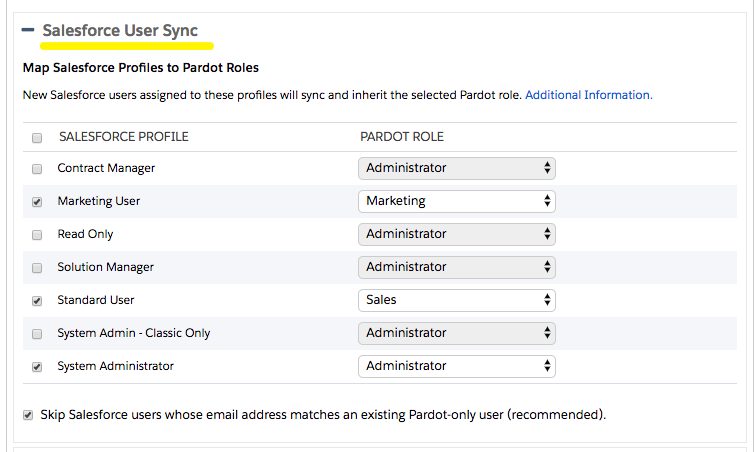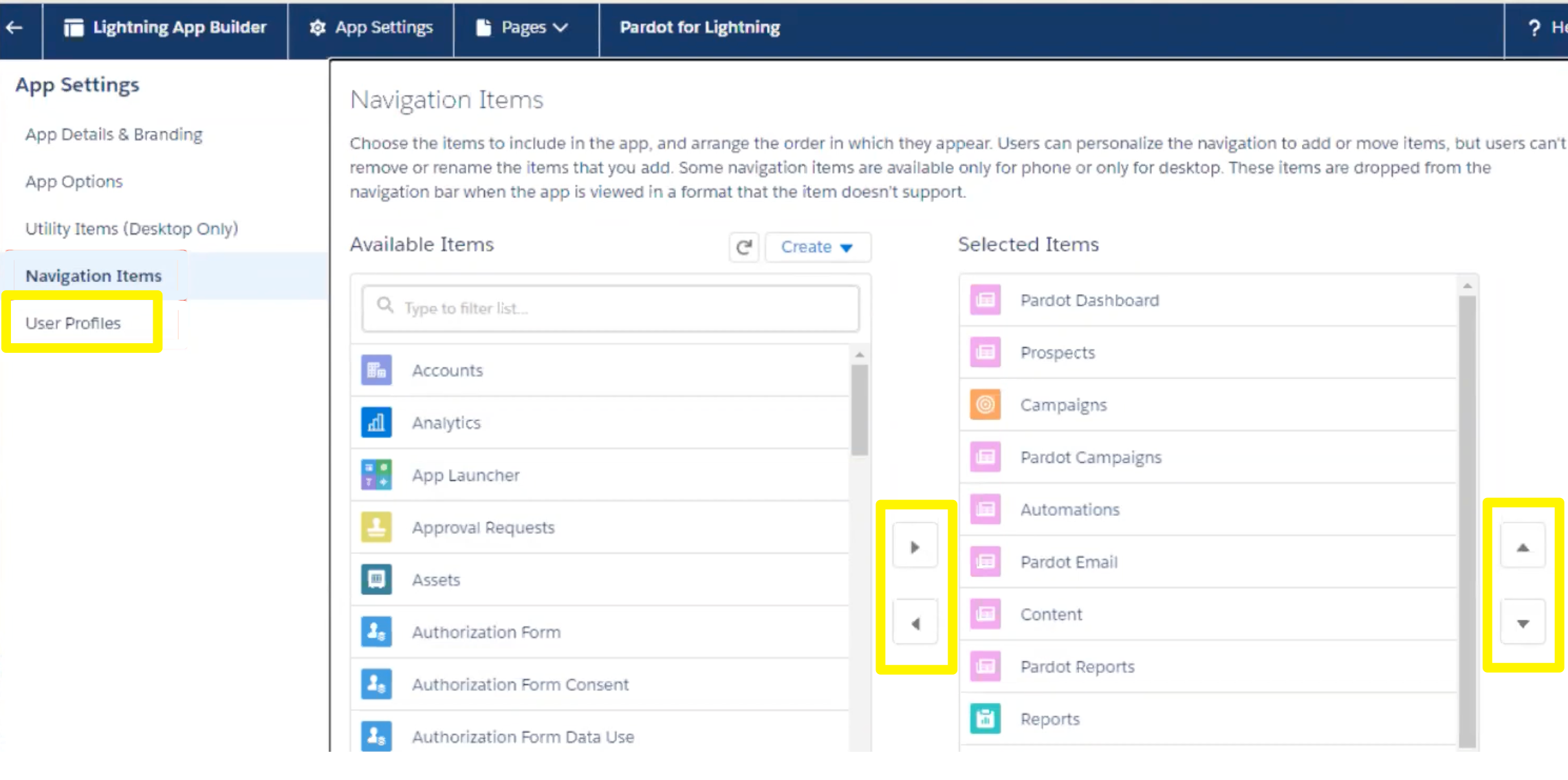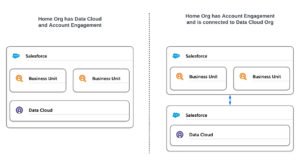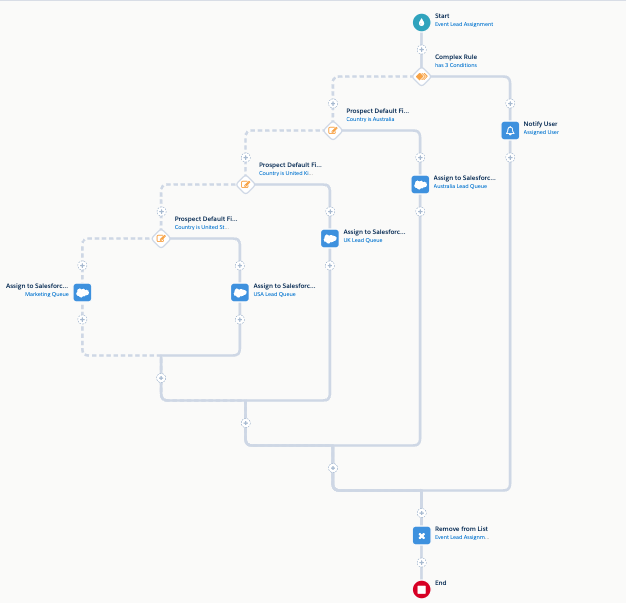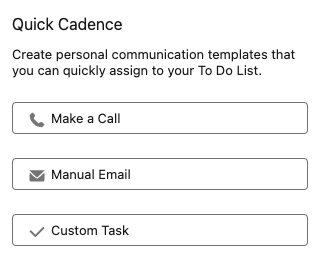How Salesforce and Pardot Admins Can Align [INFOGRAPHIC]
- June 5, 2023
- Pardot Admin, Salesforce Ben | The Drip
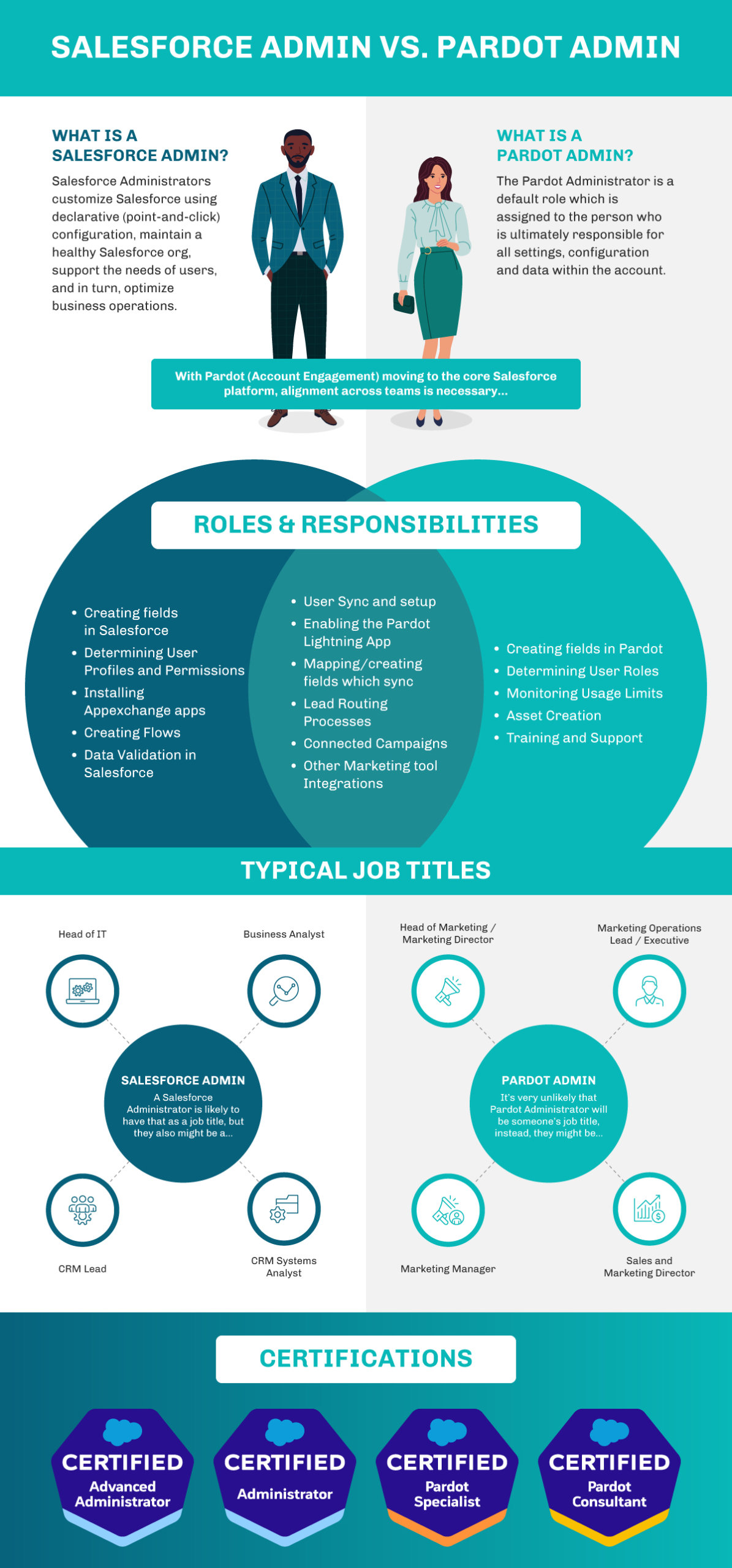

Already, with the Lightning App, the two systems look and feel more like one. Those of you reading who started using Pardot (Account Engagement) post-2019 may not know that the two used to be completely separate. Historically, that meant limited interaction between the product owners – usually limited to discussions on syncing and field creation.
Now, with SSO and the Lightning App, the line between systems can be blurred – and that is being reflected in ownership or administration. The permissions granted to a Salesforce Admin and a Pardot Admin remain different, but there are many ways in which they do need to align.
What Is a Salesforce Admin?
Salesforce Admins customize Salesforce using declarative (point-and-click) configuration, maintain a healthy Salesforce org, support the needs of users, and in turn, optimize business operations.
They carry out a core function that enables organizations to get more out of their Salesforce investment. The responsibilities of a Salesforce Admin are broader than system administrators in other industries, ranging from typical configuration-based tasks, to work that requires a level of business acumen (such as business analysis and sales operations).
What Is a Pardot (Account Engagement) Admin?
The Pardot Administrator is a default Role which is assigned to the person who is ultimately responsible for all settings, configuration, and data within the account. Pardot Admins take ownership of the Pardot (Account Engagement) account internally, as an employee of a Salesforce customer organization.
How Do the Roles Connect?
Pardot Admins and Salesforce Admins work alongside each other to ensure both connected platforms can work in harmony. But are they aligned in your organization?
A Salesforce Admin could be a Pardot Admin and vice versa, but that doesn’t have to be the case. For example, someone could have the Admin permissions in Pardot (Account Engagement), but not the System Administrator Profile in Salesforce. This is an important consideration in your implementation and planning around security in Salesforce, as the User Sync functionality does depend on Salesforce Profiles.
The Marketing Setup area in Salesforce’s setup is the ideal place to align, as Pardot Admins can be given the permission to access this area and support on tasks, such as adding new users, which have moved to core.
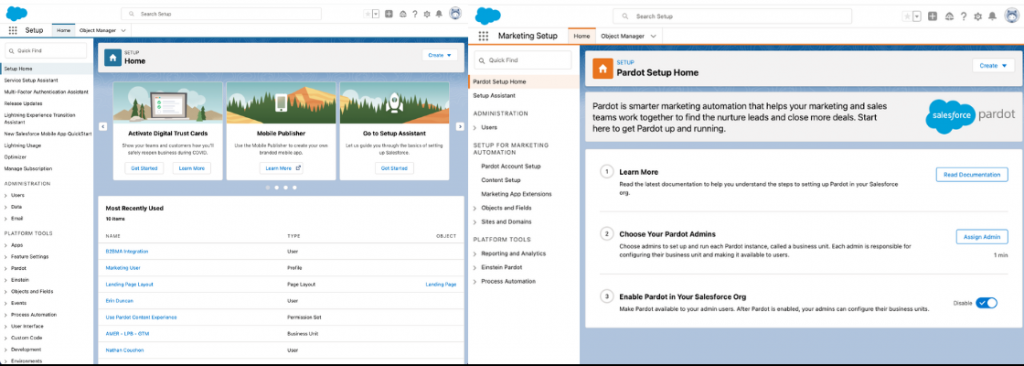

More information on how to do this can be found in the article below:
Typical Job Titles
It’s very unlikely that Pardot Administrator will be someone’s job title, instead, their job title may be more marketing related – such as ‘Marketing Manager’ or ‘Marketing Operations Lead’. This may differ by industry, for example, in the Nonprofit space, the Pardot Administrator may be known as ‘Head of Fundraising’.
A Salesforce Administrator is much more likely to have that as a job title, but they also might be ‘Head of IT’, ‘CRM Lead’, or ‘Business Analyst’. In reality, these are more like responsibilities or job functions, so when determining who does what, make sure your internal team is aligned.
Configuration Responsibilities
The responsibilities of Pardot Admins and Salesforce Admins need to be aligned in a few key areas of setup. These involve most of your User Setup, particularly with User Sync. For Pardot Administrators, it can be good to understand the basics around Permission Sets, so that you can support your Salesforce Admin when making decisions about access now and in the future.
As part of your initial setup, work together on the Lightning App setup and field syncing. Both of these are likely to change or need updating, so knowing the reasons why something is set up a certain way helps to make informed decisions. Lead Management, Connected Campaigns, and the integrations used to add new functionality will all be immensely useful to discuss together as there would be impact on users of the core platform and Pardot (Account Engagement).
Areas to align:
- User Sync and Setup
- Enabling the Pardot (Account Engagement) Lightning App
- Mapping/creating fields which sync
- Lead Routing Processes
- Connected Campaigns
- Other Marketing tool Integrations
Certifications
The Pardot Specialist and Salesforce Administrator certifications are recommended for both roles, though are not essential. For Pardot Admins, Pardot Consultant would be the next step, and this could also be useful for a Salesforce Admin at a larger organization in a more advisory role. Advanced Administrator is the next step for a Salesforce Admin.
Read more:
| Salesforce Admin Role | Pardot Admin Role | |
|---|---|---|
| Pardot Specialist Certification | ✅ | ✅ |
| Salesforce Administrator Certification | ✅ | ✅ |
| Pardot Consultant Certification | 〰️ | ✅ |
| Advanced Administrator Certification | ✅ | ❌ |
3 Top Tips
- Meet regularly: Check in once a month to discuss things like upcoming campaigns, automation requirements, and to audit your existing processes. Keep the communication open between meetings and build a good relationship.
- Learn the basics of each tool: Lean on each other’s expertise, but to best support each other it’s good to know the basic terminology and functionality of both Pardot (Account Engagement) and Core Salesforce.
- Document core functionality: Documentation will be essential in onboarding new team members or getting external support. Use descriptions within the system to document why automations are being built, linking to any external documents or tools where relevant.
Summary
Alignment between Pardot and Salesforce Admins ensures the platforms work together in harmony – which is essential now that SSO and the Lightning App have blurred the lines between the two systems. In order to align, start by understanding the key responsibilities associated with each role. Once you have established who does what and documented key processes, understanding the basics of each tool and communicating regularly will set you up for success!
This Pardot article written by:
Salesforce Ben | The Drip
Lucy Mazalon is the Head Editor & Operations Director at Salesforceben.com, Founder of THE DRIP and Salesforce Marketing Champion 2020.
Original Pardot Article: https://www.salesforceben.com/the-drip/how-salesforce-and-pardot-admins-can-align/
Find more great Pardot articles at www.salesforceben.com/the-drip/
Pardot Experts Blog
We have categorized all the different Pardot articles by topics.
Pardot Topic Categories
- Account Based Marketing (ABM) (7)
- Business Units (14)
- ChatGPT / AI (3)
- Completion Actions (5)
- Connectors (10)
- Custom Redirects (4)
- Data Cloud (2)
- Demand Generation (8)
- Dynamic Content (6)
- Einstein Features (12)
- Email Delivery (17)
- Email Open Rates (3)
- Pardot A/B Testing (2)
- Email Mailability (16)
- Do Not Email (1)
- Double Opt-in (2)
- Opt Out / Unsubscribe (14)
- Email Preferences Page (6)
- Engagement Studio (16)
- Industries (1)
- Non Profit (1)
- Landing Pages (9)
- Lead Generation (1)
- Lead Management (13)
- Lead Routing (3)
- Lead Scoring (16)
- Leads (3)
- Marketing Analytics – B2BMA (9)
- Marketing Automation (1)
- Marketing Cloud (3)
- Marketing Cloud Account Engagement (4)
- Marketing Cloud Growth (2)
- New Pardot Features (6)
- Opportunities (2)
- Optimization (2)
- Pardot Admin (64)
- Duplicates (1)
- Marketing Ops (1)
- Pardot Alerts (1)
- Pardot API (2)
- Pardot Automations (3)
- Pardot Careers (12)
- Pardot Certifications (4)
- Pardot Consulting (1)
- Pardot Cookies (3)
- Pardot Custom Objects (3)
- Pardot Email Builder (8)
- Pardot Email Templates (9)
- HML (6)
- Pardot Events (16)
- Pardot External Actions (1)
- Pardot External Activities (4)
- Pardot Forms (29)
- Form Handlers (8)
- Pardot Integrations (20)
- Data Cloud (1)
- Slack (1)
- Pardot Lead Grading (5)
- Pardot Lead Source (2)
- Pardot Lightning (1)
- Pardot Migration (1)
- Pardot Nurture / Drip Campaigns (1)
- Pardot Personalization (3)
- Pardot Profiles (1)
- Pardot Releases (18)
- Pardot Sandboxes (2)
- Pardot Segmentation (5)
- Pardot Strategy (7)
- Pardot Sync (2)
- Pardot Sync Errors (1)
- Pardot Tracker Domains (5)
- Pardot Training (3)
- Pardot Vs Other MAPs (4)
- Pardot Website Tracking (2)
- Reporting (22)
- Salesforce and Pardot (31)
- Marketing Data Sharing (2)
- Pardot Users (3)
- Salesforce Automation (5)
- Salesforce Flows (2)
- Salesforce Campaigns (20)
- Salesforce CRM (3)
- Record Types (1)
- Salesforce Engage (3)
- Salesforce Queues (2)
- Security and Privacy (1)
- Tags (3)
- The Authors (504)
- Cheshire Impact (9)
- Greenkey Digital (51)
- Invado Solutions (37)
- Jenna Molby (9)
- Marcloud Consulting (6)
- Nebula Consulting (60)
- Pardot Geeks (44)
- Salesforce Ben | The Drip (235)
- SalesLabX (3)
- Slalom (4)
- Unfettered Marketing (46)
- Uncategorized (1)
- Website Tracking (2)
- Website Search (1)
More Pardot Articles
See all posts
This Pardot article written by:
Salesforce Ben | The Drip
Lucy Mazalon is the Head Editor & Operations Director at Salesforceben.com, Founder of THE DRIP and Salesforce Marketing Champion 2020.
Original Pardot Article: https://www.salesforceben.com/the-drip/how-salesforce-and-pardot-admins-can-align/
Find more great Pardot articles at www.salesforceben.com/the-drip/

